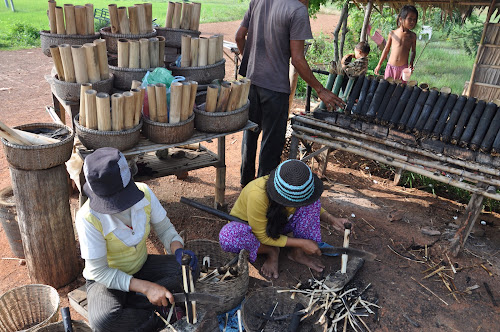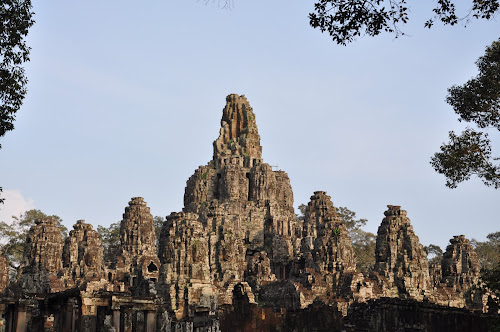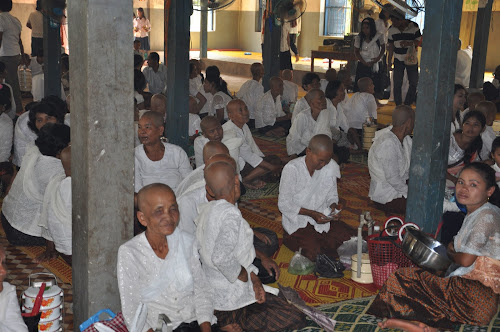Siem Reap
Finding ourselves with a week free before leaving Hong Kong, Laura and I decided to travel in Asia. Excitedly, we listed all the places we'd like to go : Myanamar, Hanoi, Cambodia...all three?! But neither of us like the idea of the check-list itinerary so we narrowed it down to one country : Cambodia. Moreover, we decided to spend the whole week based in Siem Reap to have the opportunity to develop an understanding of the history, the people and their culture in a leisurely way.
The first book on Cambodia I could get my hands on was dated 12 years ago : it spoke of needing yellow fever immunisation certificates, warned of difficulty obtaining and changing money, the menace of land-mines neear remoter temples, visa complexities and a host of other challenges. In that 12 years, so much has changed for the Cambodians, and therefore for visitors. Siem Reap retains its authenticity but is well-geared for visitors in every respect. There is a street called Pub Street...but it does actually have along and all around it some great local restaurants, fun bars and night markets. There is lodging for every budget and every type of comfort or commodity that a visitor might need. Everywhere, there is evidence of eco-tourism, recycling, tourism that supports local communities and tourists are actively discouraged from donating to street children in order to get them off the streets (and get the adults involved to use other methods of raising money. ) There is a modern, vibrant feel and energy.
The Khmer empire was immense and extremely powerful from around 800 to 1430. Yet today, it is hard not to think of the word Khmer in a very different context. The government seems to have chosen not to educate children much about the Khmer Rouge years. The younger people talk about the loss of life but don't really know what to say about it. Soldiers from both sides were integrated back into society once they surrendered towards the end of the 90's and society was asked to move on. Justice for the atrocities was sought but funding for trials was slow in coming. Eventually things started moving around 2000 and in 2009 Duch was brought to trial. Pol Pot and several of his cronies being dead, (or executed by him,) Duch was the next most sought after because of his leading role in what became the torture and killing centre of the regime. He was found guilty and three other senior KR members are still being tried. Two days ago, one of the few women survivors came forward to testify of atrocities she suffered. This is a story that will not end for a while yet. The seeming randomness and cruelty of the genocide of Vietnamese, Thais, Chams, Chinese, the educated, the urban dwellers, etc seems incomprehensible and probably needs much unraveling by UN judges, historians and Cambodians themselves ... and much time. The price of the Pol Pot's Great Cambodian Leap Forward was severe. It is told that Chou En Lai had warned him not to advance too fast...seems he took the opposite path to achieve his agrarian, secular vision for society.
Cambodia is still a poor country, one of the poorest in the world; there is corruption, the ongoing mine defusing and there are serious health challenges. Most of the population still live and work on the land since the KR forced everyone out of the towns. In the villages, people live in wooden and bamboo houses on stilts, collecting rainwater in huge urn like pots; they cook on clay and brick stoves and farm the land. Around Siem Reab the land is abundant and fertile, producing rice, twice a year near the lake, mangoes all year round, coconuts, bananas, tamarind etc. You have to feel optimistic for this young population which is so full of positive energy, good will and a genuine desire to move on, meet and welcome visitors. Cambodia seems to be full of lovely, young people. (Median age 22. Cf:US 37; UK 38)
The reasons to come to Siem Reap are many: topping the list is Angkor Wat, of course, but the whole area for more than 100 kms around has many, many temples that have to be seen. Then there is Tonle Sap lake. Cambodia is almost landlocked, apart for a stretch of coast in the west, but at its centre is an enormous freshwater lake with abundant fish and water for the population, and bird sanctuaries and floating villages for the visitor. A fascinating and unique phenomenon can be witnessed here twice a year: the flow of the rivers to and from the lake change direction. Put simply, in the dry season the lake shrinks and water trickles out to the Mekong. But after the snow melt in the Himalayas and the monsoons of the wet season, the Mekong fills and rushes into the lake; water goes up from its dry 2500 sq kms to a vast 12,000 sq kms. Obviously, Tonle sap is a phenomenal resource. However, upstream the Chinese have built a dam over the Mekong in China and there are fears of pollution coming downstream...)
In preparation for the trip I had read the book "Angkor" by the art historian and Angkor expert, Dawn Rooney, which outlines the rise and fall of the Khmer empire and describes over 50 of the Siem Reap temples as well as those of Phnom Pen. It is a beautiful book, full of photos and is the best and only guide book one might need. The four pictures above are of Angkor Wat.
There are many ways of getting around the temples : for the first day I arranged a car and a guide for the spectacular Angkor Wat, the jungle covered Ta Prohm, and the breathtaking complex of Anghor Thom. The second day we went round the smaller, lesser-visited local temples each of which were stunning in their own right, with my book as our guide, by tuk-tuk. The car's air-conditioning and the cold water and wet towels we were offered at each stop were welcome and the guide did offer interesting information about the carvings, sanskrit and construction of the temples we saw. But the motorised tuk tuk goes at a good speed and the moving air cools you nicely; moreover there is nothing between you and the environment and we loved this mode of getting about, so cheap and abundantly available. " Tuk tuk, Madame?" !
Much has been written about Angkor Wat and everyone has seen the photos, but it is not a cliche to say that nothing quite prepares you for the sight of it, the scale of it, its state of preservation and the majesty of its proportions. The three photos above are of Angkor Wat, one is of an old aspara carving and one is of young aspara dancers, today. Building began around 1113 and was inhabited until it was abandoned, neglected and over-run by jungle for over 500 years, after the centre of government moved to Phnom Pen. Anghor Wat was not rediscovered or tended for several centuries. Made of laterite or volcanic stone and sandstone, however, this temple to Shiva has survived to this day as an architectural masterpiece in spite of its age, years of neglect, plundering and nature taking its course. Built by one of the most brilliant of the Khmer rulers, Suryavarman II, it is interesting to think of it as an early contemporary of Notre Dame 1163 and Oxford University 1167 and just after Winchester Cathedral, Westminster Abbey and St. Mark's, Venice. The structure, the carvings, the bas reliefs are simply stunning.
Ta Prohm, (7 photos below,) was untouched by archeologists and restorers till very recently and its wild and ruinous state makes it a thing of considerable beauty. Nature both destroys the structure and yet holds it together. Made famous recently by a film I haven't seen yet, Lara Croft : Tomb Raider.
We spent a lot of time in the huge, tranquil, spectacular complex of Angkor Thom, created by another great Khmer leader and genius: Jayavarman VII. It must have been stunning in its heyday of around 1181 with its bronze and gold cladding and we sat for quite a while at each of the structures trying to imagine the people milling around... The buddha faces are majestic and moving; they fill you with a sense of of reverence and awe and joy and peace...they are simply sublime. Traveller/writer of the 20's, Helen Churchill Candee said of Angkor Thom's Bayon, " We stand before it stunned. There is nothing else like it in the land." (Research this woman, too : briefly married to an abusive CT man ; feminist, Titanic survivor, journalist, writer of her travels in Asia...there's a film here...! )
Day Two was a tuk tuk tour of temples I had researched and wanted to see that were quite near our lodgings in Siem Reap, the lovely Golden Banana Resort, which, apart from being beautiful and perfectly located, is run by very young, helpful and good people.
The following delight with their setting, contrasts, unique features:
Pre Rup warm brick and laterite, style and proportion..with views! The temples here are mostly "mountain temples", built up in layers like a cake...there is climbing of steep steps!
Ta Som remote, natural setting, semi- ruinous state, offers one of the classic photo opportunities (under a kapok that has engulfed a temple entrance. )
Phnom Bekheng mountain temple built on a hill, often visited at sunset, (with option of elephant ride if you need.) Had a very distressing experience here: at the top, a seeming religious leader was encouraging her "followers" to stare at the sun without closing their eyes after much praying and bowing. These were not educated or young followers and their eyes were streaming with tears. If they covered their eyes, their leader berated them and they started again to stare at a blazing sun. Horrified, I did not feel I could do nothing; so I approached and quietly tried to gesticulate to the "leader" and "followers" to stop doing this or they would damage their eyes permanently. They all stopped...for 10 minutes till I went to the other side of the monument when they started again...
Fantastic views over to Angkor.
Prasat Kravan small and probably a funerary temple but of the most beautiful proportions; again, so different to any other monument. Must be visited for the gorgeous sculptures inside the walls of the towers.
Banteay Kdei, one of our favourites; peace, monastic, jungle encroached, ruins and yet splendour; exquisite carvings.
Preah Khan a buddhist complex in ruins in dense jungle with huge sandstone garudas all around its walls; we took our time to wander and clamber around here, both in awe and with delight in the beauty of the ruins. The first photo shows the typical naga balustrade entrance and gate to the outer courtyards. Another picture shows one the the 45 giant garudas on the outer walls.
Baksei Chamkrong. Hmmm...steepest and most ruinous steps to climb. I got up easily enough by not looking down and by digging my fingers into the holes in the lava rock and pulling myself up...and then at the top had a severe attack of vertigo and freaked out! Decided that only a helicopter and ropes would ever get me down...but Laura the Explorer and a 10 year old student from a nearby orphanage, the only people around this tower, calmed and encouraged and got me down this CLIFF FACE!
But no worries, a few beers and an hour's aromatherapy massage for 12 dollars later and I was ready for the next adventure...tonight, it might be Doctor Fish! Or another 5 dollar foot massage. For sure, it will be delicious Khmer food: curries and Amok and fresh spring rolls, all of which Laura and I made at a delightful cookery class, in an "outside room" by a catfish pond in a village in the countryside. We have the recipes and are now experts and we will cook for you!
For community and eco friendly visits, we used and highly recommend Beyond Unique tours: best guides, best people. We cooked with them and visited Beng Melea and Tonle Sap lake with them. The latter trip was to floating village, Kompong Pffluk, where six communities have lived on stilt houses on the lake for centuries. We are visiting in October just before the big tourist season, so the water level is still quite high as the cooler, drier season hasn't quite set in yet;( this is the best time to come, we think! ) The mangrove forest around the lake, through which a villager took us in her boat, was submerged under the water and you could only see the canopy above water. Shades of Tai O in Lantau but then again completely different.
We were fortunate to be in Cambodia for Pchum Ben, the holiday that is similar to Cheung Yeung in Hong Kong, where the community heads to the temple to pray and make offerings for up to seven generations of ancestors and to appease the hungry ghosts. Today we visited a temple and witnessed the festivities and offerings; everyone smiled and welcomed us and all were beautifully dressed. Spirituality has come back to Cambodia in a big way since being crushed by the Khmer Rouge. The government and others have funded new temples everywhere and they are central to the life of every community.
Today, we headed to Beng Melea, where one guide book suggests you can "get in touch with your inner Indiana Jones". It is about 40kms east of Siem Reap and has only recently been completely de-mined. It is a temple where nature has completely overrun the structure in most areas and where it has held it intact in others. Supposed to be the prequel to Angkor Wat. Gorgeous day made better by our brilliant guide Sok kaa, from Beyond Unique.
Final day we visited Banteay Srei, Banteay Samre, and the Roulos group temples that date back to the 900's. The former are north of Siem Reab so we hired a driver for the day. These are two magical, fairy tale temples ... they just had us smiling with pure delight and wishing we could keep doing this for weeks...love it; love Cambodia and will be back.










































































